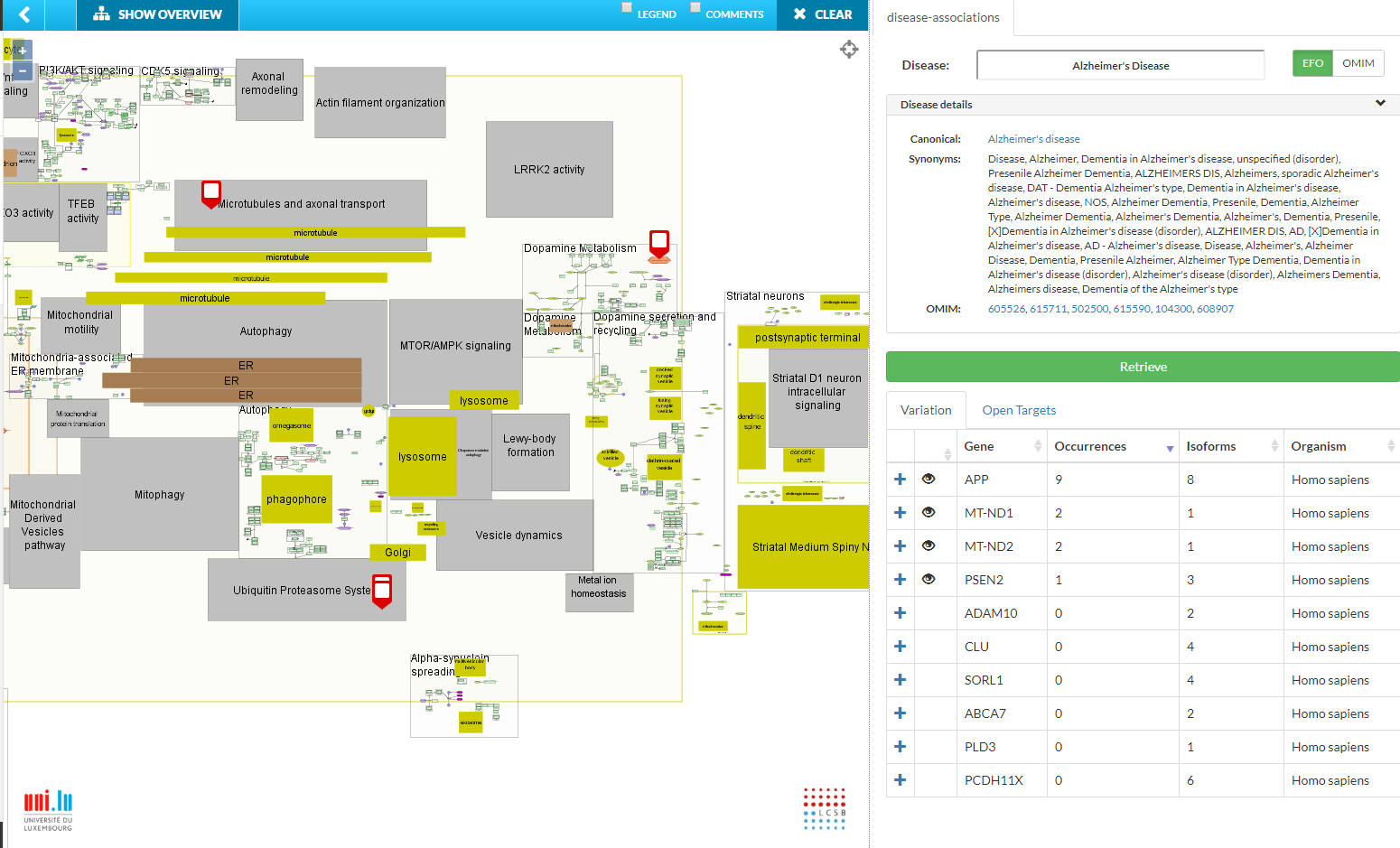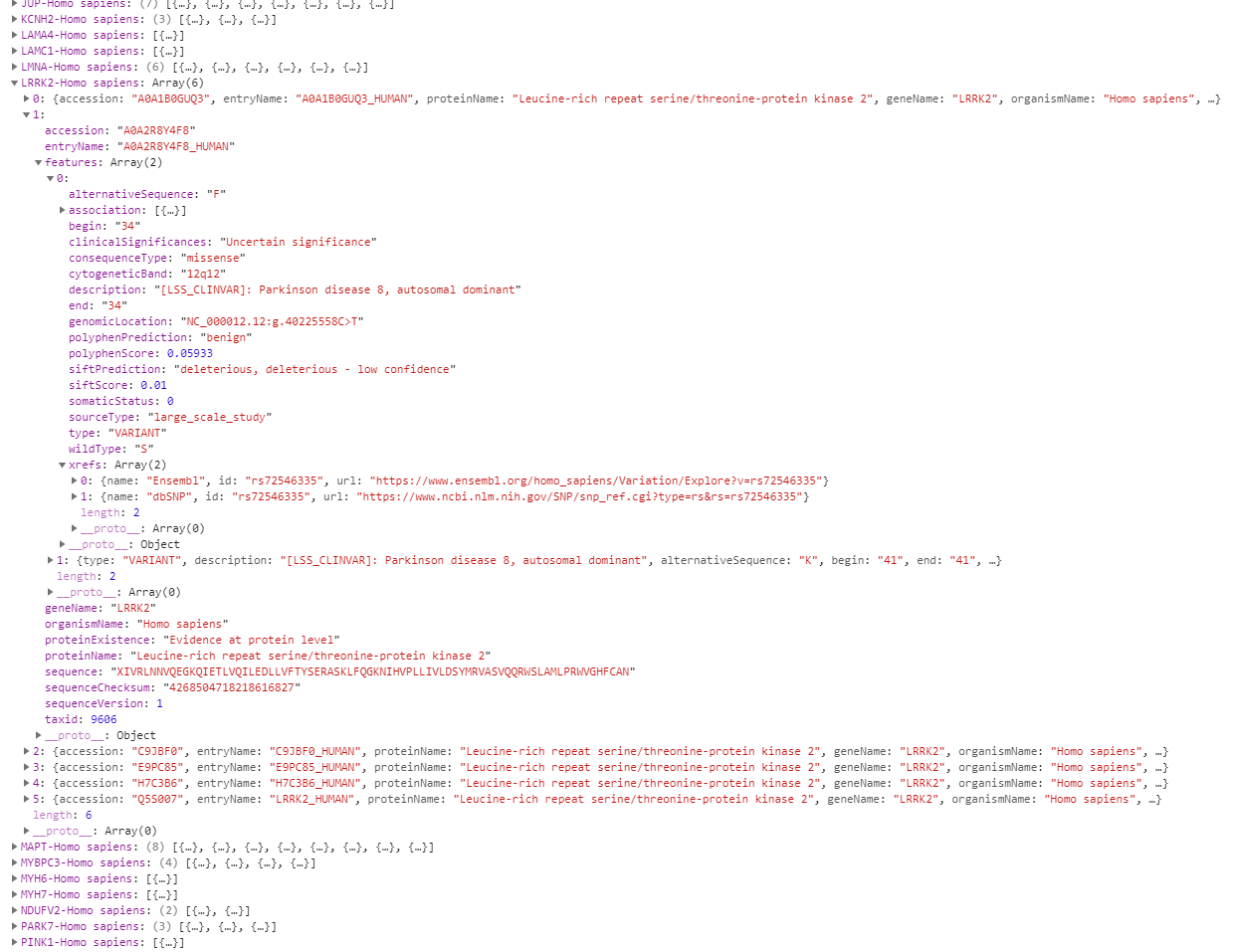Disease variant associations#
- table of contents
The introduction#
Disease associations is a plugin allowing one to see genes associated with given disease in the context of selected disease map. Currently, the plugin shows genes associations obtained from Protein API variation service (includes also information about specific variants) and Open Targets API.
Please bear in mind that the mapping between obtained genes and genes found in the map is based on HGNC. So if entities in the map do not contain HGNC annotations, there will be no mapping available, i.e. you won’t see any eye icons in the tables.
 {:width=“900px”}
{:width=“900px”}
General instructions#
In order to use the precompiled and publicly available version of the plugin, open the plugin menu in the MINERVA’s upper left corner (see image below) and click plugins. In the dialog which appears enter the following address in the URL box:
https://minerva-dev.lcsb.uni.lu/plugins/disease-associations/plugin.js
The plugin shows up in the plugins panel on the right hand side of the screen.
Plugin functionality#
Obtaining disease-gene associations#
The users picks, whether he wants to input, disease based on EFO ontology or OMIM ontology (see Variation information data source for more details).
In case EFO is selected, when the users starts inputting the disease of interest in the disease input box, the plugin starts suggesting available diseases from the EFO ontology via the EBI ontology lookup service.
After a disease is selected, the plugin shows details of the disease including its synonyms and mapped OMIM ontology terms.
In case OMIM is selected, the user needs to input OMIM ID and no additional details are provided.
After clicking on the Retrieve button, the plugin connects to the Protein API variation service and Open Targets API to retrieve all available disease-gene associations. In case of Protein API, the associations are based on the OMIM. In case of Open Targets, the associations are based directly on the EFO ID, which was used to provide the disease details.
Disease-gene associations inspection#
The obtained associations are shown in tabs based on the the source of information.
Variation information from Protein API variation service#
The variation service is used to obtain disease-associated variants retrieved from large-scale genomics projects (see details in the respective section below).
Returned variants are grouped by isoforms of genes they are involved in. The plugin groups variants in isoforms by gene name and displays them in a table where each row contains the gene name, number of occurrences of that gene in the map and number of isoforms.
The user can click on the eye icon of a particular gene to show its occurrences in the map. If there is no occurrence of given gene in the map, the number of occurrences is zero and no eye icon is displayed.
By clicking on the plus symbol in each line line, one can explore all the data which was obtained from the Protein API for that gene.
Associations from Open Targets#
Open Targets platform is used to obtain disease-gene associations including an aggregated association score showing the strength of the respective association. Only associations with score > 0.2 are retrieved and displayed. Moreover, only top 10.000 associations are retrieved, which probably will be enough for any disease.
Each association contains the involved gene, strength of the association and link to Open Targets where one can inspect detailed information about the particular association.
The user can click on the eye icon of a particular gene to show its occurrences in the map. If there is no occurrence of given gene in the map, no eye icon is displayed.
Data resources#
Ontology Lookup Service (OLS)#
EBI’s OLS is used to obtain the disease from suggestions and disease details from the EFO ontology, one of the ontologies under the OLS umbrella.
Variation information#
The information about variants comes from EBI’s Proteins API. As stated on the pages of Proteins API: > “The variation, proteomics and antigen services provide annotations imported and mapped from large scale data sources, such as 1000 Genomes, ExAC (Exome Aggregation Consortium), TCGA (The Cancer Genome Atlas), COSMIC (Catalogue Of Somatic Mutations In Cancer), PeptideAtlas, MaxQB (MaxQuant DataBase), EPD (Encyclopedia of Proteome Dynamics) and HPA, along with UniProtKB annotations for these feature types (if applicable)”.
To specify the disease of interest, the Proteins API can be passed either a text or list of OMIM identifiers. The plugin uses the latter option since the EFO ontology includes also a mapping from EFO to OMIM. For example, Parkinson’s disease is mapped to OMIM:616710, OMIM:616361, OMIM:168600. We should mention here that OMIM ontology seems to have a more granular distinction of diseases and thus for example it contains Parkinson disease 1-10 which do not have exact mapping in EFO.
The following image shows an example of the data (a snippet from Google Chrome DevTools) already grouped by gene name and species information (see above).
 {:width=“900px”}
{:width=“900px”}
Open Targets#
Open Targets platform supports workflows starting from a target or disease, and shows the available evidence for target – disease associations. The plugin uses the Open Targets Platform REST-API to obtain the associations and their scores.